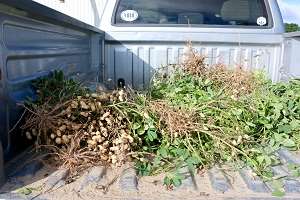By Merritt Melancon

Georgia farmers plant more than 500,000 acres of peanuts each year, but they’ll be the first to tell you that every acre is different and develops on its own timeline.
When the moneymaking part of the plant is underground, it can be hard to know when the peanuts are ready for harvest. Digging a few days early or late can make a difference of thousands of dollars.
“The peanuts that we grow in Georgia take between 135 and 140 days to mature,” said Bill Tyson, University of Georgia Cooperative Extension coordinator for Bulloch County. “But sometimes, in a year like this one when we’ve had extended hot, dry periods, sometimes we’ll dig earlier and sometimes we’ll dig later."
This year, many unirrigated, or dryland, peanut fields are skewing about a week or so later than farmers projected. The bulk of Bulloch County’s dryland peanuts should be harvested in the next week or so, Tyson said.
South Georgia UGA Extension agents like Tyson spend hours each week working with farmers to decide when they should harvest their peanuts. They don’t have X-ray vision to check on the nuts, but they do have years of practice, keen eyes, pressure washers and peanut grading boards.
By mid-September, Tyson himself has checked about 350 peanut samples pulled from the 24,000 acres of peanuts that dot Bulloch and surrounding counties. Armed with a pressure washer and the peanut grading board he’s had for a decade, Tyson spends hours inspecting peanuts at Bulloch’s five peanut buying points and in the parking lot of the Bulloch Center for Agriculture.
It’s not a complicated process, but it does take time and patience. Farmers bring in sample plants from the field in question. They pick off about 200 nuts, which are loaded into a wire basket, blasted clean with a pressure washer and dumped unceremoniously onto Tyson’s trusty board.
Each peanut plant has dozens of peanuts at different stages of maturity. Farmers want as many dark brown or black peanuts as possible because they’re worth more. The temptation is to wait until many of the plant’s light yellow, immature peanuts reach that same stage, but at that point many of those high-value older peanuts will start to separate from the vine.
“It’s a yield and quality issue, and we’re trying to maximize both,” said Tyson, explaining that a few too late or too early could be the difference between a farmer turning a profit or not. “You get paid based on the yield and the quality of your peanuts, so the better the yield and the higher the yield, the more you’re getting paid.”
Maximizing quality is even more important this year because peanut prices are projected to be low, around $407 and $429 a ton, according to price projections issued by the U.S. Department of Agriculture and cited by UGA Extension peanut agronomist Scott Monfort.
Tyson sorts the 200 nuts by color and size, and cracks a few open to check the outer coating on the kernels. Then he sweeps the board clean and issues his verdict, which varies along the lines of “Seven to 10 days,” “You’ll be OK if you start digging at the beginning of next week,” or “When did you plant these?”
Then comes more peanuts, and then more. After running 20 samples, he’ll tell you that, yes, he still likes peanut butter and jelly sandwiches. But after 50, he’ll admit that maybe he doesn’t want one for lunch today.
“This is being done wherever peanuts are being grown,” he said.
Given the dry weather, Georgia may see the dryland peanut harvest go into the last week of September or October this year.
Source: uga.edu